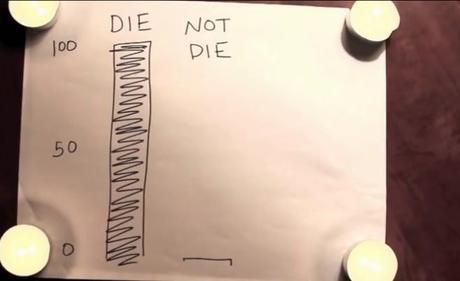 “New scientific studies allow us to predict who will die in their lifetime.” —Caitlin Doughty
“New scientific studies allow us to predict who will die in their lifetime.” —Caitlin DoughtyA while back I wrote a post Meeting Death at the Front Door, in which I said I believed that truthfulness (the niyama satya—see The Second Branch of Yoga) will help you face your death and die the way you want to, and will enable you to help your loved ones as they die. Facing death is not usually a fun topic to write about, but considering what I had learned from helping both my parents die, I had decided it was important for me to address the topic.
Notice I said that facing death is not “usually” a fun topic to write about. That’s because yesterday I was delighted to discover that there is a young woman out there, Caitlin Doughty, a mortician by trade, who is not only on a similar mission to encourage people to face death honestly but who is actually using humor to spread the word. I became intrigued by her work when I heard her being interviewed on Fresh Air yesterday about her book Smoke Gets in Your Eyes And Other Lessons from the Crematory.Although she wasn’t exactly cracking jokes during her interview (which I only heard part of), I liked her right away for her straightforwardness: “Death is going to happen to you — whether you want it to or not — and you're never going to be completely comfortable with it. But it's an important process, and please consider facing it.”
But Terry Gross mentioned Doughty’s videos and how humorous they were, so I went to her website to check them out. The first one I watched was her welcome video. Wow, she uses such a great mixture of wit, humor, and directness to get her message across—I had no idea that death kills so many people in the US alone. Welcome to Your Mortality! (I'd link to the video on youtube but can't get to it for some reason.) So, in general, I recommend her work, and in her other videos she has a lot of “death answers” for “death questions” that you might also have.But what does all this have to do with yoga? Well, first of all, we’ve been writing about the klesahs lately, the five afflictions that cause human suffering (see Attachment (Raga) to Our Ideas About Ourselves and Attachment to My Face). One of the klesahs is abhinivesah, which B.K.S. defines in Light on the Yoga Sutras both as “clinging to life” and “fear of death.” So I think the work of someone like Doughty, who is helping to dispel some of the fear around death by answering common “death questions” and encouraging people to face their own mortality, helps us cultivate satya (truthfulness) in the face of abhinivesah (fear of death/clinging to life). But really I decided to write about Doughty because of something surprising she said during her Fresh Air interview. After being asked by Terry Gross whether her job as a mortician—and being around so much death—was stressful, she admitted that it was:"Not only are you dealing with the dead bodies, you're dealing with the incredible sorrow of the families and the fact that they can get very mad at you. ... They're angry that somebody has died and they're looking for somebody to take it out on."
But then she went on to say something like (and I’m quoting from memory now):"I do take good care of myself. I have a therapist, I do yoga…."Yes, Doughty is not only practicing satya (truthfulness) to combat abhinivesah (fear of death), but she also does yoga, which I take to mean asana, to support herself in her work. And, of course, we here at YFHA all know how an asana practice—the combination of exercise and time spent focusing on mindful movement, with hopefully, some relaxing practices added into the mix—can help people deal with difficulty and stress and to support them in the important work they have committed to.You know, I never expected that I would become such a dedicated yoga practitioner. Yoga practice was not even something I chose intentionally—it was just the most convenient exercise class for me at the time. But after I kind of fell into yoga, I slowly began to realize how much it was helping me. And I eventually began to understand that it was exactly this combination of a yogic attitude toward life and an asana practice to fortify my body and my nervous system to help me maintain that attitude that I found so compelling. So here I am, still practicing—and writing about it—after all these years.Subscribe to YOGA FOR HEALTHY AGING by Email ° FollowYoga for Healthy Agingon Facebook

